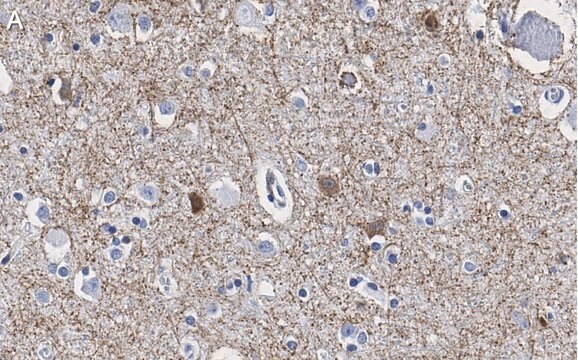ABN1380
Anti-Caspr2 Antibody, extracellular domain
serum, from rabbit
Sinonimo/i:
Contactin-associated protein-like 2, Cell recognition molecule Caspr2
About This Item
Prodotti consigliati
Origine biologica
rabbit
Livello qualitativo
Forma dell’anticorpo
serum
Tipo di anticorpo
primary antibodies
Clone
polyclonal
Reattività contro le specie
mouse
Reattività contro le specie (prevista in base all’omologia)
human (based on 100% sequence homology)
tecniche
immunocytochemistry: suitable
western blot: suitable
N° accesso NCBI
N° accesso UniProt
Condizioni di spedizione
ambient
modifica post-traduzionali bersaglio
unmodified
Informazioni sul gene
human ... CNTNAP2(26047)
Descrizione generale
Specificità
Immunogeno
Applicazioni
Immunocytochemistry Analysis: A representative lot detected Caspr2 immunoreactivity at the juxtaparanodal region around the nodes of Ranvier by indirect immunofluorescent staining of teased fibers prepared from paraformaldehyde-fixed, desheathed wild-type, but not Caspr2-knockout, mouse sciatic nerves (Gordon, A., et al. (2015). Mol. Cell. Sci. In press).
Western Blotting Analysis: A representative lot detected a lower Caspr2 level in brain tissue lysates from mice with heterozygous Caspr2-knockout than wild-type mice, while no Caspr2 expression was detected in brain samples from mice with homozygous Caspr2-knockout (Gordon, A., et al. (2015). Mol. Cell. Sci. In press).
Neuroscience
Qualità
Western Blotting Analysis (WB): A 1:5000 dilution of this antibody detected Caspr2 in 10 µg of mouse brain tissue lysate.
Descrizione del bersaglio
Stato fisico
Stoccaggio e stabilità
Handling Recommendations: Upon receipt and prior to removing the cap, centrifuge the vial and gently mix the solution. Aliquot into microcentrifuge tubes and store at -20°C. Avoid repeated freeze/thaw cycles, which may damage IgG and affect product performance.
Altre note
Esclusione di responsabilità
Non trovi il prodotto giusto?
Prova il nostro Motore di ricerca dei prodotti.
Codice della classe di stoccaggio
12 - Non Combustible Liquids
Classe di pericolosità dell'acqua (WGK)
WGK 1
Punto d’infiammabilità (°F)
Not applicable
Punto d’infiammabilità (°C)
Not applicable
Certificati d'analisi (COA)
Cerca il Certificati d'analisi (COA) digitando il numero di lotto/batch corrispondente. I numeri di lotto o di batch sono stampati sull'etichetta dei prodotti dopo la parola ‘Lotto’ o ‘Batch’.
Possiedi già questo prodotto?
I documenti relativi ai prodotti acquistati recentemente sono disponibili nell’Archivio dei documenti.
Il team dei nostri ricercatori vanta grande esperienza in tutte le aree della ricerca quali Life Science, scienza dei materiali, sintesi chimica, cromatografia, discipline analitiche, ecc..
Contatta l'Assistenza Tecnica.